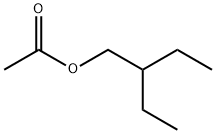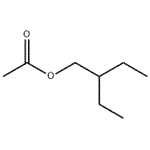Chemical Properties
Clear colorless liquid, Sp.Gr. 0.88. B.P. 163°C.
0.06 % soluble in water, soluble in alcohol,
miscible with oils.
Fruity, somewhat oily odor of rather nondescript type.
Sweet-fruity taste, reminiscent of Pear and
Strawberry.
Uses
Solvent for nitrocellulose lacquers, flavoring.
2-Ethylbutyl acetate is comparatively stable against
hydrolysis, and finds therefore some use in
soap Perfumery to lend fruity notes and lift
to the ponion of the composition. It blends
well with aldehydic and rosy fragrance types, and supports Geranium, Lavender or minty
notes excellently.
Traces of the ester arc occasionally used in
flavor compositions for fruit complexes, etc.
Usually about 5 to 8 ppm in the finished product.
Preparation
By reacting 2-ethylbutanol with acetic anhydride or acetic acid in the presence of sulfuric acid.
Definition
ChEBI: 2-Ethylbutyl acetate is a carboxylic ester.
General Description
A clear colorless liquid. Flash point 130°F. Denser than water and insoluble in water. Vapors heavier than air.
Air & Water Reactions
Flammable. Insoluble in water.
Reactivity Profile
2-Ethylbutyl acetate is an ester. Esters react with acids to liberate heat along with alcohols and acids. Strong oxidizing acids may cause a vigorous reaction that is sufficiently exothermic to ignite the reaction products. Heat is also generated by the interaction of esters with caustic solutions. Flammable hydrogen is generated by mixing esters with alkali metals and hydrides.
Hazard
Moderate fire risk.
Health Hazard
May cause toxic effects if inhaled or absorbed through skin. Inhalation or contact with material may irritate or burn skin and eyes. Fire will produce irritating, corrosive and/or toxic gases. Vapors may cause dizziness or suffocation. Runoff from fire control or dilution water may cause pollution.
Fire Hazard
HIGHLY FLAMMABLE: Will be easily ignited by heat, sparks or flames. Vapors may form explosive mixtures with air. Vapors may travel to source of ignition and flash back. Most vapors are heavier than air. They will spread along ground and collect in low or confined areas (sewers, basements, tanks). Vapor explosion hazard indoors, outdoors or in sewers. Runoff to sewer may create fire or explosion hazard. Containers may explode when heated. Many liquids are lighter than water.
Biochem/physiol Actions
Taste at 10 ppm



